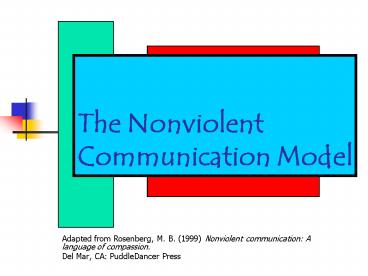The Nonviolent Communication Model PowerPoint PPT Presentation
1 / 22
Title: The Nonviolent Communication Model
1
The Nonviolent Communication Model
- Adapted from Rosenberg, M. B. (1999) Nonviolent
communication A language of compassion. - Del Mar, CA PuddleDancer Press
2
Premise
- Speaking listening play a crucial role in our
ability to stay compassionate - We can replace language that implies lack of
choice with language that acknowledges choices - Nonviolent communication is a way of
communicating that leads us to give from the heart
3
What does it do?
- A way to focus attention
- A way of communicating that leads us to give from
the heart - Guides us in reframing how we express ourselves
hear others
4
How does it work?
- By clarifying what is being observed, felt, and
needed rather than diagnosing judging, we
discover the depth of our own compassion - In keeping our attention focused on these areas,
we help others do likewise we establish a flow
of communication, back and forth, until
compassion manifests naturally
5
Four Components
- Observation
- Feelings
- Needs
- Request
6
Observation
- Entails separation of observation from evaluation
- Observations should be specific to time context
- Combining observations evaluations frequently
sounds like a criticism
7
EXERCISE
- Practicing our separate observations
8
Feelings
- Requires us to distinguish between what WE FEEL
and WHAT WE THINK - EX I feel like he should know better.
expresses a thought not a feeling - EX I feel disappointed when he promises to
drive within the speed limit and then gets
another speeding ticket. feeling
9
Feelings (cont.)
- Requires us to distinguish between what WE FEEL
and WHAT WE THINK WE ARE - I feel inadequate as a social worker.
- this is an assessment of ability as opposed to a
feeling - I feel frustrated with myself as a social
worker. feeling
10
Feelings (cont.)
- Requires us to distinguish between what WE FEEL
and HOW WE THINK OTHERS react or behave toward us - EX I feel misunderstood.
- Misunderstood reflects an assessment of
anothers level of understanding rather than a
feeling the actual feeling might be I feel
anxious or annoyed
11
Feelings (cont.)
- Entails expressing our feelings by developing a
vocabulary of feelings that allows us to clearly
specifically name or identify our emotions - List of vocabulary words attached
- (this will help with the exercise)
12
EXERCISE
- Practicing Expressing Feelings
13
Needs
- Entails acknowledging the needs behind our
feelings - What others say do may be the stimulus, but
never the cause of our feelings.
14
Needs (cont.)
- When a negative message is communicated to you,
you can choose to - Blame ourselves
- Blame others
- Sense our own feelings needs
- Sense the feelings needs hidden in the other
persons negative message
15
Needs (cont.)
- The more directly we connect our feelings to our
needs, it is easier for others to respond
compassionately - EX I feel because I .
- NOTE Judgments, criticisms, diagnoses
interpretations of others are all alienated
expressions of our own needs values.
16
EXERCISE
- Practicing Expressing Needs
17
Request
- Entails asking for actions that might fulfill our
needs - Requires use of positive language
- Requests should be clear, positive, concrete
action language that reveals what we really want
18
Request (cont.)
- Requests unaccompanied by the speakers feelings
and needs may sound like a demand - To make sure that the message sent was the
message received, ask the listener to reflect it
back
19
Request CAVEATS
- Requests are received as demands when the
listener perceives blaming or punishing will
occur if they do not comply
20
What distinguishes a request from a demand?
(observe what the speaker does if the request is
not complies with)
- Demand
- if speaker criticizes or judges if speaker lays
a guilt-trip - Request
- speaker shows empathy toward the other persons
needs
21
EXERCISE
- Practicing our Requests
22
EXERCISE
- Practicing Receiving Hearing Empathically

